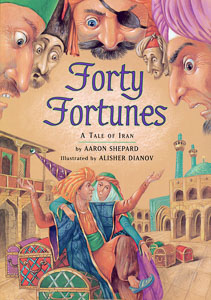Here is a longer version of the author note from my picture book.—Aaron
The story of the would‑be fortuneteller is one of the most popular tales of Iran and the rest of the Islamic world, and is found in countless versions. You might enjoy looking for them in folktale collections and discovering his additional adventures.
Divining, or fortunetelling— the attempt to discover hidden knowledge by mystic means—seems to have been practiced in every culture throughout history. In North America and Europe today, it is most widespread in the form of astrology. Also popular are Tarot cards, numerology, the I Ching, and psychic readings. There are many everyday forms as well—for instance, opening the Bible at random, or picking petals while reciting, “He loves me, he loves me not . . . .”
Dice have been used for divining for at least 4,000 years, and this was their first use, rather than for games. The Persian art of divining with dice is called raml, pronounced “RAH‑mul.” (This is not to be confused with the common Arabic form of divination, ’ilm al‑raml, known in English as “geomancy.”)
The Persian diviner throws or spins eight dice—two sets of four, with each set strung together on a brass wire. A small board may be used as a portable surface for throwing or resting the dice. The diviner then answers the question at hand by interpreting the pattern of the dice, often with the help of a book.
Here are a few notes on other elements of the story:
Isfahan. Isfahan was made the capital of Iran in 1598 by Shah Abbas the Great, and remained so for over a century. Under Abbas, the city became known as one of the most beautiful in the world, and it grew to be a major international center of commerce and the arts. This period is considered a Golden Age in Persian culture. (Persia is the former name of Iran.)
Status of women. In Iran today, it is common for women to have jobs like men. But in earlier times, most women were expected to stay home. If a woman was ambitious or dissatisfied with her lot, she could do nothing for herself. This was why she might turn instead to pressuring her husband.
Clothes. Muslim law requires both women and men to dress “modestly” in public. For Iranian men, this means covering their arms and legs with long-sleeved shirts and trousers. But Iranian women must also cover their hair and hide the shapes of their bodies. (Up until the 1920s, women had to veil their faces as well, but this is no longer the custom.)
The traditional way women cover themselves in public is with a garment called chador (pronounced “chah‑DOR”), a word that also means “tent.” It is a light one‑piece cloak and shawl combined, most often black or dark blue. The chador wraps loosely around the woman’s regular clothes—which today might be a dress or skirt as worn in Europe or America. Though women are no longer forced to wear the chador, most of them do anyway.
Public baths. For women who mostly stayed at home, trips to the public bath were an important part of their social lives. The public bath, or hammam, is a building with large, shallow pools filled with hot water—an Eastern version of the hot tub. Both men and women use the bath, but in separate rooms or at separate times.
Houses. The traditional adobe house of Iran has a flat roof used as a terrace. Stairs lead to the roof from inside, and a high wall surrounds it for privacy. Here a family camps out on summer nights to escape the heat inside the house. Because the roof is a living space, it is built to hold numbers of people—even forty!
Though many versions of this tale were consulted, I based my retelling chiefly on “The Story of the Fortune-Teller,” in Persian Tales, collected and translated by D. L. R. and E. O. Lorimer, Macmillan, London, 1919. I am indebted also to the many students, teachers, and librarians who took part in my email program Works in Progress during the first half of 1995. Their comments on an early draft were invaluable in guiding my revisions.
